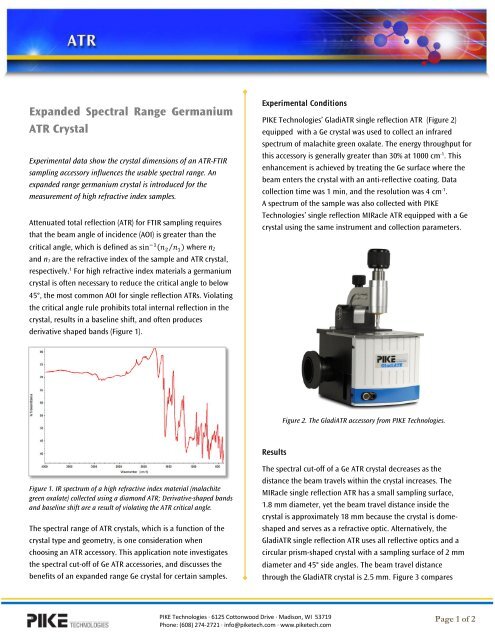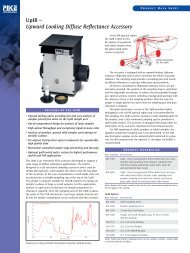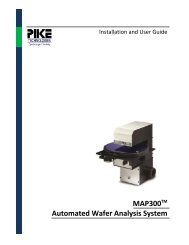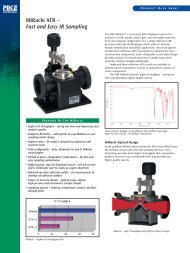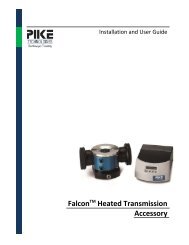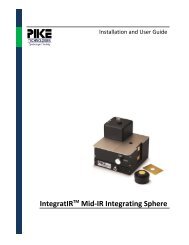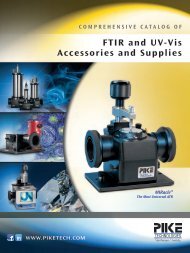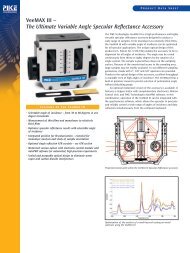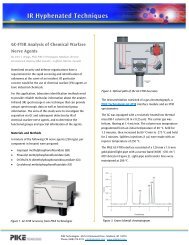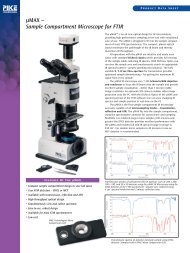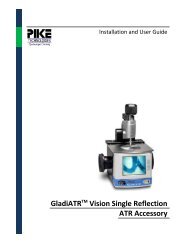Expanded Spectral Range Germanium ATR Crystal - PIKE ...
Expanded Spectral Range Germanium ATR Crystal - PIKE ...
Expanded Spectral Range Germanium ATR Crystal - PIKE ...
- No tags were found...
Create successful ePaper yourself
Turn your PDF publications into a flip-book with our unique Google optimized e-Paper software.
<strong>Expanded</strong> <strong>Spectral</strong> <strong>Range</strong> <strong>Germanium</strong><strong>ATR</strong> <strong>Crystal</strong>Experimental data show the crystal dimensions of an <strong>ATR</strong>-FTIRsampling accessory influences the usable spectral range. Anexpanded range germanium crystal is introduced for themeasurement of high refractive index samples.Attenuated total reflection (<strong>ATR</strong>) for FTIR sampling requiresthat the beam angle of incidence (AOI) is greater than theExperimental Conditions<strong>PIKE</strong> Technologies’ Gladi<strong>ATR</strong> single reflection <strong>ATR</strong> (Figure 2)equipped with a Ge crystal was used to collect an infraredspectrum of malachite green oxalate. The energy throughput forthis accessory is generally greater than 30% at 1000 cm -1 . Thisenhancement is achieved by treating the Ge surface where thebeam enters the crystal with an anti-reflective coating. Datacollection time was 1 min, and the resolution was 4 cm -1 .A spectrum of the sample was also collected with <strong>PIKE</strong>Technologies’ single reflection MIRacle <strong>ATR</strong> equipped with a Gecrystal using the same instrument and collection parameters.critical angle, which is defined as sin −1 (n 2 ⁄ n 1 ) where n 2and n 1 are the refractive index of the sample and <strong>ATR</strong> crystal,respectively. 1 For high refractive index materials a germaniumcrystal is often necessary to reduce the critical angle to below45°, the most common AOI for single reflection <strong>ATR</strong>s. Violatingthe critical angle rule prohibits total internal reflection in thecrystal, results in a baseline shift, and often producesderivative shaped bands (Figure 1).Figure 2. The Gladi<strong>ATR</strong> accessory from <strong>PIKE</strong> Technologies.ResultsFigure 1. IR spectrum of a high refractive index material (malachitegreen oxalate) collected using a diamond <strong>ATR</strong>; Derivative-shaped bandsand baseline shift are a result of violating the <strong>ATR</strong> critical angle.The spectral range of <strong>ATR</strong> crystals, which is a function of thecrystal type and geometry, is one consideration whenchoosing an <strong>ATR</strong> accessory. This application note investigatesthe spectral cut-off of Ge <strong>ATR</strong> accessories, and discusses thebenefits of an expanded range Ge crystal for certain samples.The spectral cut-off of a Ge <strong>ATR</strong> crystal decreases as thedistance the beam travels within the crystal increases. TheMIRacle single reflection <strong>ATR</strong> has a small sampling surface,1.8 mm diameter, yet the beam travel distance inside thecrystal is approximately 18 mm because the crystal is domeshapedand serves as a refractive optic. Alternatively, theGladi<strong>ATR</strong> single reflection <strong>ATR</strong> uses all reflective optics and acircular prism-shaped crystal with a sampling surface of 2 mmdiameter and 45° side angles. The beam travel distancethrough the Gladi<strong>ATR</strong> crystal is 2.5 mm. Figure 3 compares<strong>PIKE</strong> Technologies · 6125 Cottonwood Drive · Madison, WI 53719Phone: (608) 274-2721 · info@piketech.com · www.piketech.comPage 1 of 2
the spectral range of the Gladi<strong>ATR</strong> compared to the MIRacleaccessory with a Ge <strong>ATR</strong> crystal.ConclusionsThe Gladi<strong>ATR</strong>’s compact-size Ge <strong>ATR</strong> crystal in combinationwith all reflective optics offers an expanded spectral region,from 4000 to 420 cm -1 , which is beneficial when testing highrefractive index materials.<strong>PIKE</strong> Technologies would like to acknowledge Fiveash DataManagement, Inc. for providing malachite green oxalate fromtheir dye spectral database sample collection.References1<strong>PIKE</strong> Technologies. <strong>ATR</strong>: Theory and Applications.www.piketech.com.Figure 3. Energy throughput of the Gladi<strong>ATR</strong> and MIRacle accessorywith a Ge <strong>ATR</strong> crystal.Malachite green oxalate, a material dye, serves as an idealsample for <strong>ATR</strong> sampling on a Ge crystal because of its highrefractive index. The sample spectrum shows the effect ofcrystal dimensions (Figure 4). MIRacle offers a spectral rangeof 4000 – 575 cm -1 , whereas the Gladi<strong>ATR</strong>’s useable spectraldata is 4000 – 420 cm -1 , providing additional spectralinformation across the low vibrational frequencies. Types ofhigh refractive materials that would benefit from sampling onan expanded range Ge <strong>ATR</strong> crystal include inorganic materialssuch as oxides, aluminas, titania, and minerals.Figure 4. Comparing the expanded spectral range of the Gladi<strong>ATR</strong> usinga Ge <strong>ATR</strong> crystal (in red) at the low vibrational frequencies to the rangeof the MIRacle Ge <strong>ATR</strong> (in blue); sample is malachite green oxalate.<strong>PIKE</strong> Technologies · 6125 Cottonwood Drive · Madison, WI 53719Phone: (608) 274-2721 · info@piketech.com · www.piketech.comPage 2 of 2


